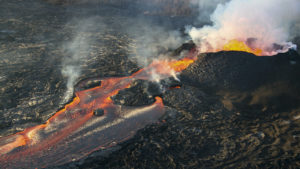by RP Ortega, April 22, 2020 in ScienceAAAS
In May 2018, Hawaii’s Kilauea volcano let loose its largest eruption in 200 years, spewing plumes of ash high into the air, and covering hundreds of homes in lava. The eruption terrified local residents, but it gave scientists a once-in-a-lifetime opportunity to study the volcano’s explosive behavior. Now, a new study claims that extreme rainfall boosted underground pressures and was the “dominant factor” in triggering the eruption.
It’s not the first time rainfall has been linked to volcanic activity, says Jenni Barclay, a volcanologist at the University of East Anglia who was not involved in the new work. Previous research suggests storms passing over Mount St. Helens may have played a role in explosive activity between 1989 and 1991. And intense rains fell shortly before and during the activity of Montserrat’s Soufrière Hills volcano from 2001 to 2003. Rain may have also triggered eruptions of Réunion’s Piton de la Fournaise volcano. Still, Barclay believes rain is, at best, a contributing factor to volcanic eruptions and not the main driver. “It’s a series of coincident events that have led to the triggering of this larger episode,” she says.
Researchers on the new study used satellite data from NASA and Japan’s space agency to estimate rainfall during the first months of 2018, before the start of the eruption. More than 2.25 meters of rain fell on the volcano in the first months of 2018, the researchers found. They created a model to show how the accumulated rainfall could seep into the pore spaces in rocks deep underground, boosting pressures that eventually caused fissures in the volcano’s flank to open up and release magma. When they looked at records of previous Kilauea eruptions going back to 1790, they found that 35—more than half—started during the nearly 6-month rainy season.

